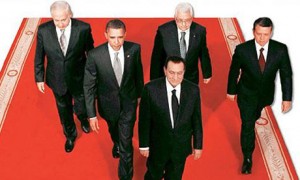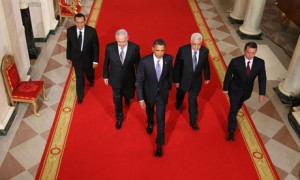“Mubarak chi?”, chiese il poliziotto della questura di Milano a proposito della cosiddetta “nipote di Mubarak”, l’amica di Berlusconi da rilasciare. Il presidente egiziano però è tenuto in gran conto dai media del suo paese, l’Egitto. Ecco come “Al Ahram”, il quotidiano più importante egiziano, ha taroccato poco tempo fa le foto di Mubarak a Washington per il summit sul medio oriente. Neanche ai tempi di Stalin si osava tanto…Altro che Mubarak chi? L’articolo è uscito sul Guardian del 17 settembre scorso (in alto la foto manipolata da Al Ahram, sotto quella originale di Getty Images):
Al-Ahram newspaper defends doctored photo of Hosni Mubarak
Altered image in state-run paper shows Egyptian president in lead role at Middle East peace talks
- Associated Press in Cairo
- guardian.co.uk, Friday 17 September 2010 18.49 BST
- Article history
Al-Ahram’s doctored image of Egyptian president Hosni Mubarak and other leaders at the Middle East peace talks in Washington. Photograph: Al-Ahram (foto sopra)
Egypt‘s oldest newspaper today defended its decision to publish a doctored photograph that appeared to put president Hosni Mubarak at the forefront of key figures at the Middle East peace talks in Washington.
The original photo showed US president Barack Obama walking in the lead on a red carpet, with Israel’s prime minister Binyamin Netanyahu, the Palestinian president Mahmoud Abbas, Mubarak and Jordan’s King Abdullah II slightly behind.
But the state-run Al-Ahram newspaper altered the image in its Tuesday edition to show Mubarak in the lead, with Obama slightly behind him to his right, then placed it over a broadsheet article titled “the Road to Sharm El Sheikh”, referring to the Egyptian Red Sea resort that hosted the second round of negotiations.
The original photograph of the five leaders. Photograph: Alex Wong/Getty Images (foto sotto)
Egyptian bloggers and activists said the picture was an example of the regime’s deception of its own people. Critics also said the photo was an attempt to distract attention from Egypt’s waning role in the Middle East peace process.
But the newspaper’s editor-in chief, Osama Saraya defended the decision in an editorial today, saying the original photo had been published on the day talks began and the new version was only meant to illustrate Egypt’s leading role in the peace process.
“The expressionist photo is … a brief, live and true expression of the prominent stance of President Mubarak in the Palestinian issue, his unique role in leading it before Washington or any other,” Saraya wrote. The photo is still posted on the newspaper’s website.
Opponents of Mubarak’s near three-decade rule seized on the controversy to criticize the government, which is accused of widespread abuses aimed at suppressing dissent. Wael Khalil, the Egyptian blogger who first called attention to the altered photo, said it was a “snapshot” of what he called daily deception about a number of issues, including democratic change and social justice.
“They lie to us all the time,” he said. “Instead of addressing the real issues, they just Photoshop it.”
Saraya accused critics of launching a smear campaign against Al-Ahram, which was first published in 1876. The newspaper has enjoyed the widest circulation in Egypt but has faced a growing challenge in recent years from a new breed of private publications and the internet.
It is not unusual for Egyptian newspapers to retouch pictures of senior officials to improve their appearance or light.



